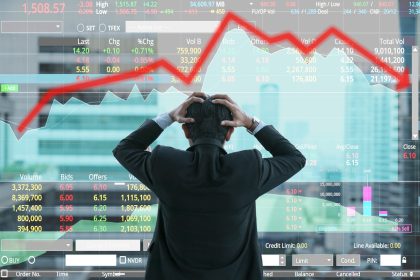America’s anti-savings policies [are crippling]
America’s anti-savings policies make saving as tough as keeping a piggy bank in a hurricane—especially for the young, old, and disadvantaged. But don’t worry, we’ve got some ways to weather the storm together.
The new un-American anti-savings policy
America is the J. Wellington Wimpy of nations, forever promising to pay its creditors on some mythical Tuesday in exchange for everything it wants today. But here’s the catch—an economy fueled purely by consumption is like a kid in a candy store: it can’t sustain itself without a severe stomachache. Overindulgence eventually devours nations, just like hypocrisy and racism gobbled up Paula Deen’s career. History is littered with the ruins of empires that crumbled under the weight of their financial mismanagement.
Take Ancient Rome, for instance. By the late fourth century, Rome was like a shopaholic maxing out its credit cards—overspending and over-taxing until the economy buckled. The final straw? A massive drop in its labor force. Sound familiar? It should.
Then there’s the Ottoman Empire, which was debt-free until 1850. But as the 19th century rolled on, the Ottomans decided they couldn’t meet their needs with taxes alone and started flirting with the dangerous allure of debt. They issued bonds that European investors snapped up like hotcakes. Fast forward, and the debt spiraled out of control, especially after WWI, leading to deficits more significant than the Baldwin brothers’ collective issues. While the Ottoman Empire had more problems than a reality TV family, its debt mismanagement was a significant factor in its eventual downfall.
And let’s not forget the USSR. Despite its iron grip, the Soviet Union couldn’t withstand an economy that moved like a sloth on tranquilizers. With low-wage workers and a government pouring over 35 percent of its GDP into the Cold War, the USSR officially called it quits on December 26, 1991. Even Russian oligarchs can’t help but wax nostalgic about the good old days, forgetting that financial instability played a starring role in their empire’s collapse.
This version maintains the historical references and humor while making the narrative more engaging.
America: Modern-day Ancient Rome?
While these empires were plagued with numerous problems that precipitated their falls, they demonstrate the weakening of a former superpower on the world stage partly because of fiscal instability. America should take heed.
In 2000, the U.S. national debt was $5.6 trillion. In 2008, it was $10 trillion. Today, it stands at $35.22 trillion. Since the Presidency of the honorable Richard Nixon, the U.S. national debt as a percentage of GDP has virtually increased nonstop and is now close to WWII levels.
While the public sector has shown itself as responsible with the nation’s money as Bernie Madoff, the private sector is not doing better. The 7th Annual Savings Survey, released last month, found that only 68 percent of Americans spend less than they earn and save the difference. In comparison, only 64 percent have emergency funds to help with unexpected expenses.
The Wall Street Journal also reported on a separate survey by the U.S. Department of Commerce showing that the personal savings rate was only 3.9 percent in December 2013. The average retirement savings rate is 6.4 percent, even though most Americans believe it should be 10 percent.
Because it doesn’t rain pennies from heaven
Why isn’t America saving as Ben Franklin so wisely advised? Instead of following his thrifty path, we’ve become devoted disciples of John Maynard Keynes, embracing Keynesian policies that practically hand out gold stars for spending and detention slips for saving. This obsession with consumption has created a low-interest-rate environment where saving is about as thrilling as reading Gwyneth Paltrow’s guide to ‘conscious uncoupling.’
Remember the last time you heard about a bank offering a killer interest rate? Probably back in 2008, when you could still snag more than 2 percent on a savings account. Fast forward to today, and the best savings accounts offer rates between 0.75 percent and 0.95 percent. If you park $1,000 in one of these accounts, you’ll be rewarded with a whopping $9.50 in a year—enough to treat yourself and a loved one to one-and-a-half lattes at Starbucks. With incentives like that, it’s no wonder saving has become about as appealing as a budget vacation at the local strip mall.
This low-interest-rate environment, designed to spur spending, hurts younger savers and retirees the most. Kids and young adults just starting to earn money have to stash it somewhere but often don’t qualify for checking and brokerage accounts due to low balances. In the past, they’d kick off their financial journey with a trusty savings account, eventually graduating to checking accounts, then investing and IRAs. But today, they’re missing out on the magic of compound interest, the financial fairy dust that can turn pennies into dollars over time.
Meanwhile, retirees and those nearing retirement, who usually lean towards conservative investments like savings accounts, CDs, and bonds, are being nudged—or shoved—into riskier investments to keep pace with inflation. It’s either that or downgrade their golden years to a steady diet of McDonald’s dinners and nights at the local YMCA. America’s love affair with low interest rates might keep the spending engine humming, but it’s leaving our savers in the dust, wondering what happened to the good old days when saving was worth something.
Colleges are crippling savings
Another shining example of America’s anti-savings agenda is the tax on college savings. As college tuition has skyrocketed faster than a Richard Branson space plane—reaching an average of over $39,400 per year for private colleges in 2023—our higher education system has increasingly sent a clear message: saving for college is for suckers, and spending like there’s no tomorrow is the way to go.
Here’s how it plays out: Colleges use the federal government’s Free Application for Federal Student Aid (FAFSA) form to gather all the financial dirt on students and their parents. Armed with this information, they calculate how much each student should pay in tuition. And here’s the kicker—all things being equal, students who have been diligent enough to save are often rewarded with a higher tuition bill, while those with no savings get a discount. It’s like a reverse reward system—save more, pay more!
To add insult to injury, students without savings are often pushed into borrowing through the federally subsidized student loan program. The average student loan debt for the Class of 2023 is over $37,000. It’s like being told, ‘Congratulations! You don’t have any savings? Here, have some debt instead!’ The system practically shoves students into the arms of lenders, making borrowing the only viable option to cover soaring tuition costs.
So, while parents might think they’re doing the right thing by saving for their kid’s college education, the reality is that the system is designed to punish those who plan. Instead of being rewarded for financial responsibility, they pay more and watch as their savings are practically penalized. In America’s topsy-turvy world of higher education finance, the best strategy might be to stuff that college fund under the mattress and hope for the best—or perhaps hope that your kid becomes the next Richard Branson and pays their own way to the stars.
Anti-savings – a bi-partisan effort
The Democrat and Republican parties are as indistinguishable as the Olsen Twins—if you squint, you might convince yourself there’s a difference, but good luck telling them apart in a lineup. Sure, they use different buzzwords to rally their bases, but when it comes to their loyalties and policies, they’re practically carbon copies. Democrats have long been branded as ‘big-spending liberals,’ proudly waving the Keynesian flag. But here’s the dirty little secret: Republicans haven’t been the party of supply-side economics since Ronald Reagan hung up his cowboy boots.
Take Republican President George W. Bush, for example. In 2001 and 2008, he handed out rebate checks like candy on Halloween, famously encouraging Americans to ‘go shopping more’ to boost the economy. These are not the words of a champion of production-based economics—they’re straight out of the Keynesian playbook, where consumption reigns supreme. It’s right up there with Newsweek’s eyebrow-raising suggestion that Americans should stop saving altogether. To their credit, Newsweek didn’t stop there—they also advised American businesses to quit saving. Bold move, Newsweek.
Then there’s President Obama’s nomination of Janet Yellen to replace Ben Bernanke as Federal Reserve Chair. The only thing remotely surprising about this was the embrace of diversity by nominating a woman. Yellen, however, is as committed as her predecessor to the easy money policies that have been stalling the recovery since the Great Recession. It’s like swapping out one identical twin for another—the face changes, but the policies don’t.
As Jeremy Grantham, co-founder of money management firm GMO, recently pointed out in Fortune Magazine: ‘Higher interest rates would have increased the wealth of savers. Instead, they became collateral damage of Bernanke’s policies.’ The idea behind low interest rates is to spur capital spending, right? So, why is capital spending still dragging its feet at this cycle stage? Grantham notes there’s no evidence that quantitative easing has done anything to boost capital spending.
And here’s a juicy tidbit to chew on: Companies in the S&P 500 broke records, sitting on over $1 trillion in cash by 2013, with no signs of slowing down in 2014 or beyond. So, while working hard for your next paycheck, remember that corporate America is hoarding cash like it’s going out of style. And that, my friends, is bipartisan fiscal policy—two parties, one strategy: keep the consumption train rolling, and to heck with the savers.
Give Hayek hella love
Our policymakers and business leaders have fully embraced Keynesian economics, transforming America into a full-blown consumption economy. It’s like we’ve traded in our work boots for shopping carts, and the service sector has been the economy’s golden child since the housing market took a nosedive in 2008. We’re all about consuming, but when it comes to saving or investing? Well, that’s about as popular as a salad bar at a barbecue.
Here’s the thing: no single economic theory always works for all economies. Positions like the presidency and Fed chair aren’t just fancy titles; they’re revolving doors for a reason—policies, including economic ones, need constant tweaking and adjustment to match the day’s economic climate. It’s like trying to cook the perfect dish; you can’t always use the same recipe and expect it to turn out right. Sometimes, you must add a little spice or turn up the heat.
But if interest rates stay stuck at rock bottom, we’re looking at a future where capital spending, personal investment, and savings become rarer than a unicorn at a rodeo. Why? Because when the expected return is low, people won’t bother saving or investing—it’s just not worth it. On the other hand, if interest rates go up, people will start to see the opportunity cost of not saving or investing. When returns look good, even the most spend-happy among us might be tempted to sock away a few dollars.
It’s high time for the Federal Open Market Committee (FOMC) to ditch its easy money policy and give interest rates a nudge upwards. Politicians in Washington, D.C., must roll up their sleeves and implement pro-growth economic policies that boost production and curb our consumption obsession. And while they’re at it, they could try practicing a bit of fiscal austerity with the government’s coffers. Meanwhile, American businesses should stop hoarding cash like it’s the last roll of toilet paper in a pandemic and start investing in capital spending, research, and development. Oh, and selling jobs to the world’s lowest bidders? That needs to stop. It’s time to bring the jobs home and put American innovation back in the driver’s seat.
These are our recommendations to breathe new life into the U.S. economy. But let’s be real—with Janet Yellen’s nomination as Fed Chair, we’re probably in for more of the same economic and government policies we’ve seen since 2001. Just because Albert Einstein defined insanity as doing the same thing repeatedly and expecting different results doesn’t mean we’ve learned to avoid it. We’re more committed to that definition than any meaningful change.
Get more help with saving money:
Read the full article here






